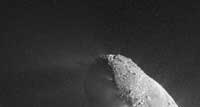 NASA's EPOXI mission spacecraft successfully flew past comet Hartley 2 at 7 a.m. PDT (10 a.m. EDT) Thursday, November 4, 2010. Scientists say initial images from the flyby provide new information about the comet's volume and material spewing from its surface.
NASA's EPOXI mission spacecraft successfully flew past comet Hartley 2 at 7 a.m. PDT (10 a.m. EDT) Thursday, November 4, 2010. Scientists say initial images from the flyby provide new information about the comet's volume and material spewing from its surface.
"Early observations of the comet show that, for the first time, we may be able to connect activity to individual features on the nucleus," said EPOXI Principal Investigator Michael A'Hearn of the University of Maryland, College Park. "We certainly have our hands full. The images are full of great cometary data, and that's what we hoped for."
EPOXI is an extended mission that uses the already in-flight Deep Impact spacecraft. Its encounter phase with Hartley 2 began at 1 p.m. PDT (4 p.m. EDT) on Nov. 3, when the spacecraft began to point its two imagers at the comet's nucleus. Imaging of the nucleus began one hour later.
"The spacecraft has provided the most extensive observations of a comet in history," said Ed Weiler, associate administrator for NASA's Science Mission Directorate at the agency's headquarters in Washington. "Scientists and engineers have successfully squeezed world-class science from a re-purposed spacecraft at a fraction of the cost to taxpayers of a new science project."
Images from the EPOXI mission reveal comet Hartley 2 to have 100 times less volume than comet Tempel 1, the first target of Deep Impact. More revelations about Hartley 2 are expected as analysis continues.
Initial estimates indicate the spacecraft was about 700 kilometers (435 miles) from the comet at the closest-approach point. That's almost the exact distance that was calculated by engineers in advance of the flyby.
"It is a testament to our team's skill that we nailed the flyby distance to a comet that likes to move around the sky so much," said Tim Larson, EPOXI project manager at NASA's Jet Propulsion Laboratory in Pasadena, Calif. "While it's great to see the images coming down, there is still work to be done. We have another three weeks of imaging during our outbound journey."
The name EPOXI is a combination of the names for the two extended mission components: the Extrasolar Planet Observations and Characterization (EPOCh), and the flyby of comet Hartley 2, called the Deep Impact Extended Investigation (DIXI). The spacecraft has retained the name "Deep Impact." In 2005, Deep Impact successfully released an impactor into the path of comet Tempel 1.
NASA's Jet Propulsion Laboratory, a division of the California Institute of Technology, manages the EPOXI mission for NASA's Science Mission Directorate. The spacecraft was built for NASA by Ball Aerospace & Technologies Corp., in Boulder, Colo.
DC Agle 818-393-9011
Jet Propulsion Laboratory, Pasadena, Calif.
agle@jpl.nasa.gov
Trent J. Perrotto 202-358-0321
NASA Headquarters, Washington
Trent.j.perrotto@nasa.gov
Lee Tune 301-405-4679
University of Maryland, College Park
ltune@umd.edu
This image from the High-Resolution Instrument on NASA's EPOXI mission spacecraft shows part of the nucleus of comet Hartley 2. The sun is illuminating the nucleus from the right. A distinct cloud of individual particles is visible. This image was obtained on Nov. 4, 2010, the day the EPOXI mission spacecraft made its closest approach to the comet.
(Courtesy NASA/JPL-Caltech/UMD)
 Cometary Flurries
Cometary Flurries
This zoomed-in image from the High-Resolution Instrument on NASA's EPOXI mission spacecraft shows the particles swirling in a "snow storm" around the nucleus of comet Hartley 2.
Scientists estimate the size of the largest particles ranges from a golf ball to a basketball. They have determined these are icy particles rather than dust. The particles are believed to be very porous and fluffy.
The sun is illuminating the nucleus from the right. This image was obtained on Nov. 4, 2010, the day the EPOXI mission spacecraft made its closest approach to the comet.
(Courtesy NASA/JPL-Caltech/UMD)
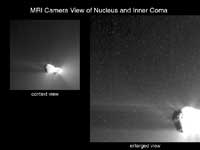 Views of Hartley 2 Nucleus and Inner Coma
Views of Hartley 2 Nucleus and Inner Coma
The Medium-Resolution Instrument on NASA's EPOXI mission spacecraft obtained these views of the icy particle cloud around comet Hartley 2. The image on the left is the full image of comet Hartley 2 for context, and the image on the right was enlarged and cropped.
The images confirm that the particles seen in the High-Resolution Instrument images are real and not artifacts.
This image was obtained on Nov. 4, 2010, the day the EPOXI mission spacecraft made its closest approach to the comet.
(Courtesy NASA/JPL-Caltech/UMD/Brown)
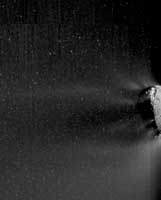 Icy Particle Spray
Icy Particle Spray
This movie made from images obtained by NASA's EPOXI mission spacecraft shows an active end of the nucleus of comet Hartley 2. Icy particles spew from the surface. The specks move as the movie toggles back and forth. Most of these particles are traveling with the nucleus. They are fluffy "snowballs" about 3 centimeters to 30 centimeters (1 inch to 1 foot) across.
The images for the movie were obtained by the Medium Resolution Imager on Nov. 4, 2010, the day the EPOXI mission spacecraft made its closest approach to the comet.
(Courtesy NASA/JPL-Caltech/UMD/Brown)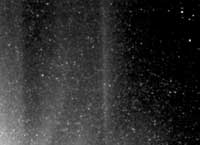 Tracking "Snowballs"
Tracking "Snowballs"
This movie shows the motion of some icy particles in the cloud around Hartley 2, as seen by NASA's EPOXI mission spacecraft. A star moving through the background is marked with red and moves in a particular direction and with a particular speed, while the icy particles move in random directions. The icy particles are marked in green, blue and light blue.
The images for the movie were obtained by the Medium-Resolution Imager on Nov. 4, 2010, the day the EPOXI mission spacecraft made its closest approach to the comet.
(Courtesy NASA/JPL-Caltech/UMD/Brown)
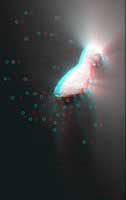 Hartley 2 in 3-D
Hartley 2 in 3-D
This 3-D image shows the entire nucleus of Hartley 2 with jets and an icy particle cloud. Circles have been added to highlight the location of individual particles.
The images used to make this 3-D image, known as an anaglyph, were obtained by the Medium-Resolution Imager on Nov. 4, 2010, the day the EPOXI mission spacecraft made its closest approach to the comet.
This 3-D image should be seen with blue-red glasses, where the red lens is in front of the left eye.
(Courtesy NASA/JPL-Caltech/UMD/Brown)
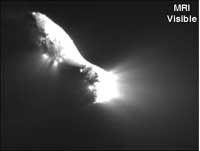 The Many Faces of Hartley 2
The Many Faces of Hartley 2
Infrared scans of comet Hartley 2 by NASA's EPOXI mission spacecraft show carbon dioxide, dust, and ice being distributed in a similar way and emanating from apparently the same locations on the nucleus. Water vapor, however, has a different distribution implying a different source region and process.
These maps were made from data obtained by the High-Resolution Imager on Nov. 4, 2010.
(Courtesy NASA/JPL-Caltech/UMD)
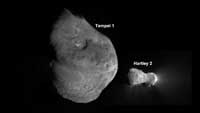 Tempel 1 and Hartley 2
Tempel 1 and Hartley 2
This image shows the nuclei of comets Tempel 1 and Hartley 2, as imaged by NASA's Deep Impact spacecraft, which continued as an extended mission known as EPOXI.
Tempel 1 is five times larger than Hartley 2. Visible jets are easily seen in images of Hartley 2, but required extensive processing to be seen in images of Tempel 1.
Tempel 1 is 7.6 kilometers (4.7 miles) in the longest dimension. Hartley 2 is 2.2 km (1.4 miles) long.
The Tempel 1 image was built up from more than 25 images captured by the impactor targeting sensor on July 4, 2005. The Hartley 2 image was obtained by the Medium- Resolution Imager on Nov. 4, 2010.
(Courtesy NASA/JPL-Caltech/UMD)
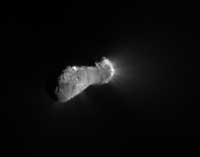 Closing in on Comet Hartley 2
Closing in on Comet Hartley 2
This close-up view of comet Hartley 2 was taken as NASA's EPOXI mission approached the comet at 6:58 a.m. PDT (9:58 a.m. EDT). The spacecraft's Medium-Resolution Instrument snapped the picture from a distance of 1,417 kilometers (880 miles). The sun is to the right.
The comet's nucleus, or main body, is approximately 2 kilometers (1.2 miles) long and .4 kilometers (.25 miles) at the "neck," or most narrow portion. Jets can be seen streaming out of the nucleus.
(Courtesy NASA/JPL-Caltech/UMD)
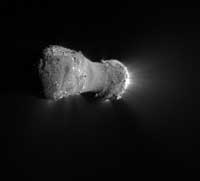 Almost There at Comet Hartley 2
Almost There at Comet Hartley 2
This close-up view of comet Hartley 2 was taken as NASA's EPOXI mission approached the comet at 6:59 a.m. PDT (9:59 a.m. EDT). The spacecraft's Medium-Resolution Instrument snapped the picture from a distance of 816 kilometers (507 miles). The sun is to the right.
The comet's nucleus, or main body, is approximately 2 kilometers (1.2 miles) long and .4 kilometers (.25 miles) at the "neck," or most narrow portion. Jets can be seen streaming out of the nucleus.
(Courtesy NASA/JPL-Caltech/UMD)
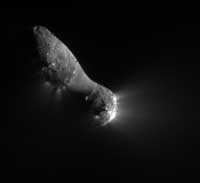 Slipping By Comet Hartley 2
Slipping By Comet Hartley 2
This close-up view of comet Hartley 2 was taken at 7:00 a.m. PDT (10 a.m. EDT), after NASA's EPOXI mission flew by. The spacecraft's Medium-Resolution Instrument snapped the picture from a distance of 849 kilometers (528 miles). The sun is to the right.
The comet's nucleus, or main body, is approximately 2 kilometers (1.2 miles) long and .4 kilometers (.25 miles) at the "neck," or most narrow portion. Jets can be seen streaming out of the nucleus.
(Courtesy NASA/JPL-Caltech/UMD)
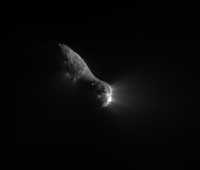 Leaving Comet Hartley 2
Leaving Comet Hartley 2
This close-up view of comet Hartley 2 was taken at 7:01 a.m. PDT (10:01 a.m. EDT), after NASA's EPOXI mission flew by. The spacecraft's Medium-Resolution Instrument snapped the picture from a distance of 1406 kilometers (874 miles). The sun is to the right.
The comet's nucleus, or main body, is approximately 2 kilometers (1.2 miles) long and .4 kilometers (.25 miles) at the "neck," or most narrow portion. Jets can be seen streaming out of the nucleus.
(Courtesy NASA/JPL-Caltech/UMD)
 Flying Under Comet Hartley 2
Flying Under Comet Hartley 2
This image montage shows comet Hartley 2 as NASA's EPOXI mission approached and flew under the comet. The images progress in time clockwise, starting at the top left.
The image was taken by EPOXI's Medium-Resolution Instrument on Nov. 4, 2010. The sun is to the right.
(Courtesy NASA/JPL-Caltech/UMD)
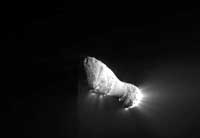 Introducing Comet Hartley 2
Introducing Comet Hartley 2
Comet Hartley 2 can be seen in glorious detail in this image from NASA's EPOXI mission. It was taken as the spacecraft flew by around 6:59 a.m. PDT (9:59 a.m. EDT), from a distance of about 700 kilometers (435 miles). The comet's nucleus, or main body, is approximately 2 kilometers (1.2 miles) long and .4 kilometers (.25 miles) at the "neck," or most narrow portion. Jets can be seen streaming out of the nucleus.
The mission's Medium-Resolution Instrument was used to capture this view.
(Courtesy NASA/JPL-Caltech/UMD)
 Evidence for a First-of-Its-Kind Comet Jet
Evidence for a First-of-Its-Kind Comet Jet
These three pairs of images from NASA's EPOXI mission demonstrate that a dust jet and gaseous carbon dioxide are being released from comet Hartley 2 at the same time, and from the same location on the comet. The observations suggest that carbon dioxide is driving the jet and taking tiny grains with it as it spews out of the nucleus of the comet. This is the first time this type of jet has been observed.
The top row consists of three images showing carbon dioxide gas being released by the comet at different points in time, from when the comet was at its minimum brightness to its maximum brightness. The bottom row of images shows dust coming from a jet on the comet at the same three points in time. The observations demonstrate that the gas and the jet are coming from the same location on the comet at the same time. This, in turn, suggests that the carbon dioxide is driving the jet.
The presence of this jet tells the scientists that the comet is made of chunks rich in solid carbon dioxide, sort of like chocolate chip chunks in frozen cookie dough. What's more, this variability in the comet's composition implies that the ingredients for both comets and planets must have been mixed up early on in the formation of our solar system. Without this mixing, comets would have more homogenous composition -- in simple terms, this would be having comets made of just "dough," and comets made of just "chocolate chunks."
The top-row images show data taken by the spacecraft's infrared spectrometer, a part of the High-Resolution Instrument. The bottom row images were taken in visible light by the spacecraft's Medium-Resolution Instrument.
(Courtesy NASA/JPL-Caltech/UMD)
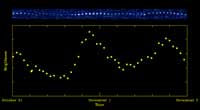 Gas and Dust In Sync
Gas and Dust In Sync
The upper panel of this figure shows small images of the comet, specially filtered to show only carbon dioxide, or evaporated dry ice, as a function of time (shown at the bottom). The brightness varies dramatically from one image to another, which means that the amount of carbon dioxide emitted by the comet is varying up and down. A close look at the images shows that the position of the carbon dioxide also varies by a small amount, up and down in the pictures, just as the brightness varies.
The lower panel is a graph showing the variation of total brightness, and thus the variation of the total amount of carbon dioxide, during the time period. The amount of carbon dioxide emitted very late on Oct. 31 is more than four times greater than earlier on that same day. During this same period of two days, the water (not shown) varied much less than the carbon dioxide. This suggests that some chunks of the comet's nucleus have much more dry ice relative to water than do other chunks.
Carbon dioxide is a basic ingredient of comets and planets in our solar system. Scientists on the EPOXI team think that sunlight is warming the comet, causing its frozen, sub-surface carbon dioxide to bubble up into gas that is escaping in jets.
These data were collected by EPOXI's infrared spectrometer, part of its High-Resolution Instrument.
(Courtesy NASA/JPL-Caltech/UMD)
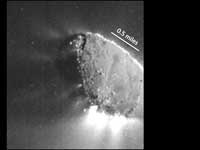 Jets Galore
Jets Galore
This enhanced image, one of the closest taken of comet Hartley 2 by NASA's EPOXI mission, shows jets and where they originate from the surface. There are jets outgassing from the sunward side, the night side, and along the terminator -- the line between the two sides.
The image was taken by EPOXI's Medium-Resolution Instrument on Nov. 4, 2010. The sun is to the right.
(Courtesy NASA/JPL-Caltech/UMD)
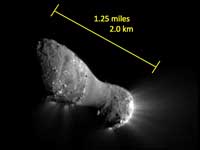 Up Close and Personal with Hartley 2
Up Close and Personal with Hartley 2
The image, one of the closest taken of comet Hartley 2 by NASA's EPOXI mission, shows many features across the comet's surface. The length of the comet is equal to the distance between the Capitol building and the Washington Monument in Washington. There are two obvious regions of jet activity associated with rough terrain. The smooth surface in the middle is lower than the rest of the comet and may accumulate fine-grain dust.
The image was taken by EPOXI's Medium-Resolution Instrument on Nov. 4, 2010. The sun is to the right.
(Courtesy NASA/JPL-Caltech/UMD)
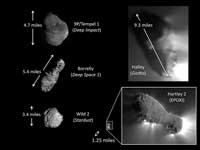 Fab Five
Fab Five
This montage shows the only five comets imaged up close with spacecraft. The comets vary in shape and size. Comet Hartley 2 is by far the smallest and the most active of small comets. This jet activity can be seen extending from the comet's surface and into its outer shell of gas and dust, or coma. This is first time scientists have been able to link jets to the details of the surface.
(Courtesy NASA/JPL-Caltech/UMD)
